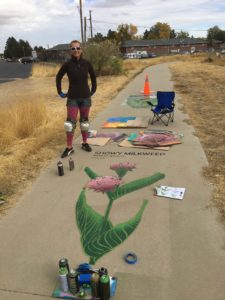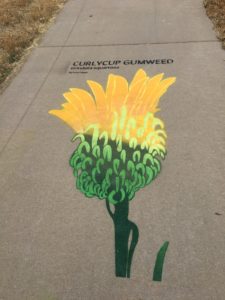 Katy is an artist and regenerative gardener. Her mission is to cultivate joy and vitality by connecting people to each other and to the land where we live, work, and play. This project is about utilizing art to connect people who use the Highline Canal path to two of the native plant species that can be found along its edges and that have medicinal properties. Many of the indigenous tribes who lived on this land used the native plants for healing and wellness. In today’s world we call them “weeds” and either ignore them, yank them, or pour chemicals on them. What if instead, we start noticing the beauty and abundance of these magical creatures and celebrate them as gifts from our Great Mother Earth?
Katy is an artist and regenerative gardener. Her mission is to cultivate joy and vitality by connecting people to each other and to the land where we live, work, and play. This project is about utilizing art to connect people who use the Highline Canal path to two of the native plant species that can be found along its edges and that have medicinal properties. Many of the indigenous tribes who lived on this land used the native plants for healing and wellness. In today’s world we call them “weeds” and either ignore them, yank them, or pour chemicals on them. What if instead, we start noticing the beauty and abundance of these magical creatures and celebrate them as gifts from our Great Mother Earth?
*The imagery and information in this project are not intended as medical advice, but simply an introduction to identifying local plants and to encourage individual research into wild herbal remedies and natural ways of increasing overall wellness. If you come across a wild plant you suspect might be medicinal, please take the time to honor the gifts it has to offer by researching the best way to harvest, process and utilize it for wellness. Consult a local, licensed herbalist as well as your doctor about incorporating it into your lifestyle. Also, please take precautions that it is not a poisonous look-alike and, especially if in an urban environment, be aware that it is likely tainted with chemicals or other urban pollution and may not be safe for consumption or medicinal use.

COMMON NAME: Showy Milkweed
BOTANICAL NAME: Asclepais speciosa
FAMILY: Asclepiadaceae
PARTS USED: Roots (medicinal) young leaves and seed pods (edible)
HABITAT: Native to Western North America, grows in prairies, in sandy and loamy, moister soils, usually on roadsides, in fields, and wastelands. Extremely important food and habitat for the survival of monarch butterflies as they evolved together, and milkweed plants are the only place monarchs will lay their eggs since it is the only food Monarch larvae will eat.
TRADITIONAL USES: Native Americans used the fiber in the stems for rope, baskets, and nets. The fluffy white floss, attached to milkweed’s flat brown seeds, can be used to stuff pillows, mattresses, and quilts, and was carried as tinder to start fires.
Internal Uses:
Kidney stones Kidney weakness Expectorant Anti-spasmodic Gall bladder attacks
External Uses:
Latex used to cure warts
DO NOT USE IN CASE OF: Pregnant or breastfeeding
CAUTIONS: Some may have an allergic reaction to the sap and avoid getting sap in eyes. May be toxic when taken internally, without proper preparation. Seek consultation from a clinically certified herbalist prior to ingesting.

COMMON NAME: Curlycup Gumweed
BOTANICAL NAME: Grindelia squarrosa
FAMILY: Asteraceae
PARTS USED: Flowers & Leaves
HABITAT: Native to Colorado, it favors dry areas, but grows on moist soils that lack other vegetation. It is most common in dry prairies, waste places, roadsides, railroads, depleted rangelands, and abandoned croplands.
TRADITIONAL USES: American Indians used the gummy secretions of curly cup gumweed to relieve asthma, bronchitis, and colic. Pawnee Indians boiled leaves and flowering tops to treat saddle sores and raw skin. Today, medicinal uses include treatment of bronchial spasm, whooping cough, asthma, and rashes caused by poison ivy.
Internal Uses: Extract is valuable as a stimulant, sedative, astringent, purgative, emetic, diuretic, antiseptic, and disinfectant Bronchitis Bladder infections Anti-microbial Anti-inflammatory Anti-spasmodic for dry/hacking coughs Relaxing Expectorant Asthma Allergies Calming to nervous heart palpitations Indigestion
External Uses: Wounds Accelerates healing Stimulates skin regeneration Poison Oak/ Poison Ivy (combined with apple cider vinegar)
DO NOT USE IN CASE OF: Pregnant or breastfeeding
CAUTIONS: May cause allergic reaction in people sensitive to the Asteraceae/Compositae family (i.e. ragweed, chrysanthemums, marigolds, daisies, etc.). Do not use in high doses as it could be potentially irritating to the kidneys and gastrointestinal tract.







